ASTM E2656-25 药用水总有机碳属性的实时释放测试
VIP免费
This international standard was developed in accordance with internationally recognized principles on standardization established in the Decision on Principles for the
Development of International Standards,Guides and Recommendations issued by the World Trade Organization Technical Barriers to Trade(TBT)Committee.
Designation:E2656-25
INTERNATIOMAL
Standard Practice for
Real-time Release Testing of Pharmaceutical Water for the
Total Organic Carbon Attribute
This standard is issued under the fixed designation E2656;the number immediately following the designation indicates the year of
original adoption or,in the case of revision,the year of last revision.A number in parentheses indicates the year of last reapproval.A
superscript epsilon(ε)indicates an editorial change since the last revision or reapproval.
1.Scope
1.1 This practice establishes an approach to the real-time
release testing(RTRT)of pharmaceutical water based on the
total organic carbon(TOC)attribute using on-line total organic
carbon(OLTOC)instrumentation that is in agreement with
current regulatory thinking.
1.2 This practice is harmonized with or supports the con-
cepts of relevant ASTM International Committee E55 on
Manufacture of Pharmaceutical Products standards,ICH Har-
monized Tripartite Guidelines,the U.S.FDA PAT Guidance,
and U.S.FDA Pharmaceutical CGMPs.
1.3 This practice does not provide general guidance infor-
mation for pharmaceutical procedures that are considered
standard practice in the pharmaceutical industry.This practice
provides specific guidance for non-standardized procedures.
1.4 This practice does not address the user's various internal
procedures for risk,change,or quality management systems.
The overall project effort associated with this practice shall be
proportional to the overall risk of failing the pharmaceutical
water's TOC concentration specification.
1.5 This practice does not purport to establish how to
comply with pharmacopeias.The RTRT methodology selected
must assure compliance with the user's current required
pharmacopeias.However,compliance with pharmacopeia TOC
methods is not necessarily sufficient to meet current regulatory
expectations for RTRT.
1.6 This practice does not purport to substitute for or replace
compendial bioburden testing requirements.It is strictly appli-
cable to the TOC attribute of water quality.
1.7 This standard does not purport to address all of the
safety concerns,if any,associated with its use.It is the
responsibility of the user of this standard to establish appro-
priate safety,health,and environmental practices and deter-
mine the applicability of regulatory limitations prior to use.
!This practice is under the jurisdiction of ASTM Committee E55 on Manufac-
ture of Pharmaceutical and Biopharmaceutical Products and is the direct responsi-
bility of Subcommittee E55.12 on Process Applications.
Current edition approved Jan.1,2025.Published January 2025.Originally
approved in 2010.Last previous edition approved in 2016 as E2656-16.DOI:
10.1520/E2656-25.
1.8 This international standard was developed in accor-
dance with internationally recognized principles on standard-
ization established in the Decision on Principles for the
Development of International Standards,Guides and Recom-
mendations issued by the World Trade Organization Technical
Barriers to Trade(TBT)Committee.
2.Referenced Documents
2.1 ASTM Standards:²
E2281 Practice for Process Capability and Performance
Measurement
E2363 Terminology Relating to Manufacturing of Pharma-
ceutical and Biopharmaceutical Products in the Pharma-
ceutical and Biopharmaceutical Industry
E2500 Guide for Specification,Design,and Verification of
Pharmaceutical and Biopharmaceutical Manufacturing
Systems and Equipment
E2537 Guide for Application of Continuous Process Verifi-
cation to Pharmaceutical and Biopharmaceutical Manu-
facturing
D4839 Test Method for Total Carbon and Organic Carbon in
Water by Ultraviolet,or Persulfate Oxidation,or Both,and
Infrared Detection
D5173 Guide for On-Line Monitoring of Total Organic
Carbon in Water by Oxidation and Detection of Resulting
Carbon Dioxide
D5904 Test Method for Total Carbon,Inorganic Carbon,and
Organic Carbon in Water by Ultraviolet,Persulfate
Oxidation,and Membrane Conductivity Detection
D5997 Test Method for On-Line Monitoring of Total
Carbon,Inorganic Carbon in Water by Ultraviolet,Persul-
fate Oxidation,and Membrane Conductivity Detection
D6317 Test Method for Low Level Determination of Total
Carbon,Inorganic Carbon and Organic Carbon in Water
by Ultraviolet,Persulfate Oxidation,and Membrane Con-
ductivity Detection
²For referenced ASTM standards,visit the ASTM website,www.astm.org,or
contact ASTM Customer Service at www.astmorg/contact.For Annua Book of
ASTM Standards volume information,refer to the standard's Document Summary
page on the ASTM website.
Copyrght OASTM International,100 Barr Harbor Drive,PO Box C700,West Conshohocken,PA 19428-2959.United States
工
2
2.2 Other Reference Documents:
ICH Q2(R2)Validation of Analytical Procedures:Text and
Methodology ³
ICHQ7 Good Manufacturing Practice Guide for Active
Pharmaceutical Ingredients³
ICHQ8(R2) Pharmaceutical Development³
ICHQ9(R1) Quality Risk Management³
ICHQ10 Pharmaceutical Quality System³
ISO 15839 Water Quality —On-line Sensors/Analyzing
Equipment for Water:Specifications and Performance
Tests⁴
JP Chapter<2.59> Test for Total Organic Carbon⁵
Ph.Eur.Chapter<2.2.44> Total Organic Carbon in Water
for Pharmaceutical Use⁶
U.S.FDA Part 11 Guidance Guidance for Industry:Part 11,
Electronic Records;Electronic Signatures —Scope and
Application ⁷
U.S.FDA PAT Guidance Guidance for Industry:PAT—A
Framework for Innovative Pharmaceutical Development,
Manufacturing,and Quality Assurance⁷
U.S.FDA Pharmaceutical CGMPs Pharmaceutical CGMPs
for the 21st Century —A Risk-Based Approach⁷
U.S.FDA Procedures and Methods Validation Guidance for
Industry:Analytical Procedures and Methods Validation
Chemistry,Manufacturing,and Controls Documentation⁷
U.S.FDA Process Validation Guidance Guidance for Indus-
try:Process Validation:General Principles and Practices⁷
USP Chapter<643> Total Organic Carbon(TOC)⁸
USP Chapter<1225> Validation of Compendial Procedures⁸
USP Chapter<1226> Verification of Compendial Proce-
dures ⁸
USP Chapter<1231>Water for Pharmaceutical Purposes⁸
USP Guidance<1058> Analytical Instrument Qualification⁸
3.Terminology
3.1 For definitions of terms specific to this standard,refer to
the Terminology sections of Practice E2281,Terminology
E2363,and Guide E2500. Refer to ICHQ2(R2)for method
validation terminology.
4.Summary of Practice
4.1 This practice provides the user with sufficient guidance
for developing the scientific and risk-based information nec-
3Available from International Conference on Harmonisation of Technical
Requirements for Registration of Pharmaceuticals for Human Use(ICH),ICH
Secretariat,c/o IFPMA,15 ch.Louis-Dunant,P.O.Box 195,1211 Geneva 20,
Switzerland,http://www.ich.org.
4Available from International Organization for Standardization(ISO),1,ch.de
la Voie-Creuse,Case postale 56,CH-1211,Geneva 20,Switzerland,http://
www.iso.ch.
5Available from Japanese Pharmacopoeia(JP),Standards Division,Office of
Compliance and Standards,Pharmaceuticals and Medical Devices Agency(PMDA),
Shin-kasumigaseki Building,3-3-2,Kasumigaseki,Chiyoda-ku,Tokyo 100-0013,
Japan,http://www.std.pmda.go.jp.
⁶Available from European Pharmacopoeia(Ph.Eur.),7 allee Kastner,CS 30026,
F67081 Strasbourg,France,http://www.pheur.org.
7Available from Food and Drug Administration (FDA),5600 Fishers Ln.,
Rockville,MD 20857,http://www.fda.gov.
8Available from U.S.Pharmacopeia(USP),12601 Twinbrook Pkwy.,Rockville,
MD 20852-1790,http://www.usp.org.
essary to make informed decisions on the implementation,
continuous verification,and continuous improvement of a
system to provide the real-time release testing of pharmaceu-
tical water using on-line total organic carbon(RTRT-OLTOC)
instrumentation that meets pharmaceutical water TOC specifi-
cations.This guidance is based on Practice E2281,Terminol-
ogy E2363 ,and Guide E2500 standards as well as
ICH Q2(R2),ICH Q7,ICH Q8(R2),ICH Q9(R1),and
ICH Q10 guidelines.The following steps are required to meet
the objectives of this practice.
4.1.1 Technical Evaluation—Evaluate and understand water
systems,TOC measurement technologies,and the related
regulatory requirements.
4.1.2 Risk Assessment—Perform quality risk analysis on the
prospective RTRT system designs to establish the sampling
locations representative of the point-of-use.
4.1.3 Data Quality—Ensure the quality of the data from the
TOC measurement system is suitable for the intended use in
the water RTRT system.Ensure equivalency/consistency to
data from existing TOC measurement systems used to release
water to the TOC attribute,if they exist.
4.1.4 Implementation Strategies—Develop process to as-
sure successful implementation of RTRT
4.1.5 Continuous Verification Procedures—Develop quality
control strategies to ensure consistent system performance.
4.1.6 Continuous Process Improvement—Assess and imple-
ment process improvement practices.
5.Significance and Use
5.1 Pharmaceutical water is the most common component
or ingredient used in pharmaceutical and biopharmaceutical
manufacturing.Acceptable purity of the water is important to
the quality of the final pharmaceutical product.TOC concen-
tration is a key indicator and attribute of the purity of this water
and also an important monitor of the overall performance of the
water purification system.TOC analysis is the measurement of
all the covalently bound carbon present in the water,not
including carbon in the form of carbon dioxide(CO₂),bicar-
bonate ion (HCO₃),or carbonate ion(CO₃²),and is reported
as the mass of organic carbon per volume.
5.2 Application of this practice provides pertinent informa-
tion to make informed decisions on the release of water
meeting pharmaceutical TOC concentration specifications.
6.Procedure
6.1 Technical Evaluation:
6.1.1 The overall project scope shall be proportional to the
associated risk of exceeding the pharmaceutical water TOC
concentration specifications.Knowledge and understanding of
the TOC concentration in the water system,the OLTOC
measurement system technology performance,and the phar-
maceutical water system design shall be acquired to minimize
risk,ensure correct quality decisions,and maximize return on
investment (USP Chapter<1231>and (1-7)⁹).TOC measure-
ment technologies are referenced in Test Methods D4839,
D5904,D5997 ,and D6317,and Guide D5173.
9The boldface numbers in parentheses refer to a list of references at the end of
this standard.
3
6.1.2 Technical assessments should be conducted to evalu-
ate and develop a risk-based,science-based RTRT-OLTOC
system design.Knowledge of related information from avail-
able sources should be used to understand,interpret,and
implement the results of the technical assessments.Information
on general and specific RTRT-OLTOC system design
considerations,performance characteristics,and validation can
be found in published documents and texts(8-15).
6.1.3 For existing water purification systems,the user
should assess historical,current,and potential organic contami-
nation.Evaluation of potential organic contamination should
be based on a realistic assessment of water system design and
components to determine the probability of a specific or a
broad spectrum of organic contaminants reaching the water
distribution system.The user should consult with TOC instru-
mentation vendors to determine if the TOC measurement
system will meet the requirements of the intended application
in light of any organic contamination assessment.
6.1.4 For new water purification systems,the presence of
potential problematic compounds in the pharmaceutical water
system shall be addressed during the design and qualification
and validation activities and correction/mitigation/preventive
actions shall be implemented accordingly.
6.1.5 TOC measurement system technology assessments
shall be achieved by meeting regulatory guidance requirements
on analytical procedure verifications and validations
(ICH Q2(R2),USP Chapter<1225>,and U.S.FDA Proce-
dures and Methods Validation).The requirements shall depend
on the use of the data and the intended use of the instrumen-
tation.
6.1.5.1 Legal U.S.Requirements and Verification of
USP Chapter<643>—The use of USP Chapter<643>TOC is
legally recognized to meet the requirements for testing the
TOC attribute in pharmaceutical water.The users of
USP Chapter<643>TOC are not required to validate this
practice,but they shall verify it is suitable under actual
conditions of use.The user shall understand that Section
501(b)of the U.S.Food,Drug,and Cosmetic Act(the Act)
legally recognizes the analytical procedures in the U.S.
Pharmacopeia/National Formulary(USP/NF)for purposes of
determining compliance with this Act(U.S.FDA Procedures
and Methods Validation).The U.S.Federal Regulation CFR
211.194(a)(2)states:the suitability of a compendial analytical
procedure must be verified under actual conditions of use.
Users shall use USP Chapter<1226>,ICH Q2(R2),or equiva-
lent to verify compendial procedures.
6.1.5.2 The procedure for validation and verification of the
TOC analytical method shall depend on the analytical proce-
dure classification in ICH Q2(R2),USP Chapter<1225>,or
the U.S.FDA Procedures and Methods Validation.The mea-
surement of the TOC attribute in water shall be classified as an
impurity test.Under impurity tests are two additional
classifications,quantitative and limit test.For each of these,
there are recommended lists of validation tests to perform.All
pharmacopeia TOC test methods are limit tests.Limit testing
produces only a pass or fail output as graphically represented
by Fig.1.To control,trend,and monitor on-line systems and to
release water in real time using quantitative data,the analytical
method requires the use of quantitative data,so the analytical
method shall be validated to the requirements of quantitative
tests(U.S.FDA PAT Guidance).Quantitative data use is
graphically represented in Fig.2. Classifications and recom-
mended tests are shown in Table 1. Additional helpful infor-
mation can be found in ISO 15839.
6.1.5.3 The U.S.FDA considers "real-time release testing to
be comparable to Alternative Analytical Procedures”and the
U.S.Regulation CFR 211.165 requires that the accuracy,
sensitivity,specificity,and reproducibility of the alternative
analytical test methods or procedures used for process control
purposes be validated and documented.
6.2 Risk Assessment:
6.2.1 If the TOC concentration data is to be used in a
quantitative way for trending,process control,or process
Limit Test for TOC Analysis:
Only allows "Pass"or "Fail"outputs
Fail
500
Pass
0+
Jan-08 Feb-08 Mar-08 Apr-08 May-08 Jun-08 Jul-08 Aug-08 Sep-08 Oct-08 Nov-08 Dec-08
TOC Specification
Pass
FIG.1 “Information Poor”Limit Test Output
Toa
l
Org
ani
c
Car
bon
(pp
b)
摘要:
展开>>
收起<<
ThisinternationalstandardwasdevelopedinaccordancewithinternationallyrecognizedprinciplesonstandardizationestablishedintheDecisiononPrinciplesfortheDevelopmentofInternationalStandards,GuidesandRecommendationsissuedbytheWorldTradeOrganizationTechnicalBarrierstoTrade(TBT)Committee.Designation:E2656-25I...
声明:如果您的权利被侵害,请联系我们的进行举报。
相关推荐
-
RBA8.0官方中文版VIP免费

 2025-11-16 12
2025-11-16 12 -
新版RBA责任商业联盟一整套文件(含管理手册、全套程序文件及对应表单)
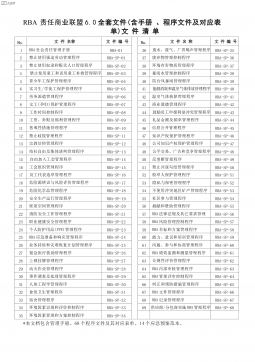
 2025-11-17 22
2025-11-17 22 -
最新最全面RBA(原EICC)社会责任程序文件(77个程序+相关表格)

 2025-11-17 19
2025-11-17 19 -
RBA-SP-067 供应商分包商实施RBA管理程序
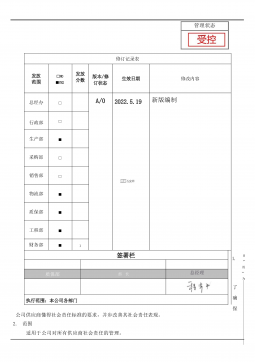
 2025-11-18 10
2025-11-18 10 -
RBA-SP-066 记录管理程序
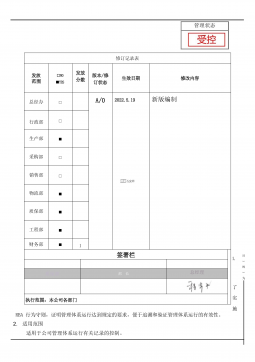
 2025-11-18 12
2025-11-18 12 -
RBA-SP-065 文件管理程序

 2025-11-18 9
2025-11-18 9 -
RBA-SP-064 纠正和预防措施管理程序RBA8.0
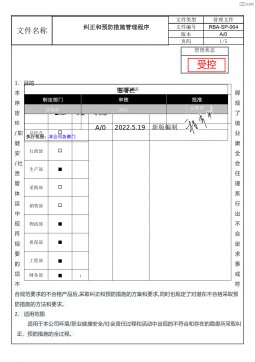
 2025-11-18 14
2025-11-18 14 -
RBA-SP-063 管理评审控制程序
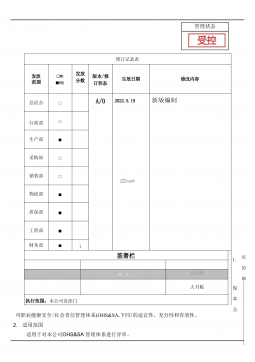
 2025-11-18 10
2025-11-18 10 -
RBA-SP-062 内部审核管理程序

 2025-11-18 12
2025-11-18 12 -
RBA-SP-061 合规性评价管理程序

 2025-11-18 19
2025-11-18 19
作者: 51zlzl
分类:法规规范
价格:60质量币
属性:8 页
大小:471.36KB
格式:PDF
时间:2025-11-27


